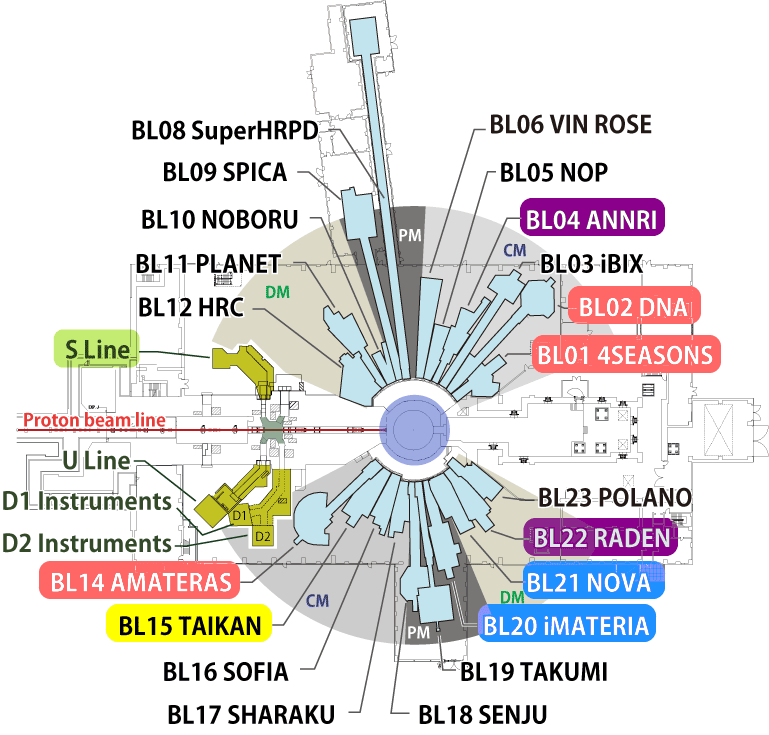Course Descriptions

Inelastic Neutron Scattering
Diffraction
SANS/Reflectometry
Elemental analysis/Imaging
Muon
BL01: 4SEASONS
The Study of Lattice Dynamics in Crystalline Material using Inelastic Neutron Scattering
Inelastic neutron scattering is an experimental method that is used to observe and measure the micro-vibration (dynamics) of atoms and spins in a sample material. By observing the difference in energy between the incident and scattered neutrons, the magnitudes, distances, and directions of the forces acting between the atoms or spins in the sample can be determined.
In this course, students will measure atomic vibrations (phonons) in a single crystal by inelastic neutron scattering using the chopper spectrometer 4SEASONS. By analyzing the data, students will learn what kinds of forces act between atoms and how they affect the macroscopic properties.
BL02: DNA
The Study of Molecular Dynamics on the Nanosecond Timescale using Quasielastic Neutron Scattering
Quasielastic neutron scattering is considered to be one of the most effective techniques for measuring the dissipation motion (e.g. fluctuation or diffusion) of atoms, molecules and spins in a material. In particular, in a number of widely-used functional materials ? such as in lithium secondary batteries or fuel cells, solid state ionic conductors play an important role. In these solid state ionic conductors, the ions or hydrogen atoms are moving at a speed similar to that of the liquid state ? even at around room temperature. These dynamic motions of ions and hydrogen atoms can be measured at the nanosecond timescale using quasi-elastic neutron scattering.
In this course, students will use the DNA high-resolution spectrometer to study the hydrogen ion dynamics in a Nafion ion exchange membrane ? a material that is currently in practical use in polymer electrolyte fuel cells. At the same time, students will learn how to analyze the data from a typical quasielastic neutron scattering experiment.
BL14: AMATERAS
Study on the Dynamics of Liquids using Quasi-elastic Neutron Scattering
By carefully measuring the energy difference between incident and scattered neutrons, it is possible not only to determine the atomic or magnetic structure of a material but also to probe the motion of atoms, molecules and spins (atomic magnets). This method is called inelastic neutron scattering (INS), which is a powerful technique for investigating the dynamics of materials. When the measured difference in energy is very small, the technique is known as quasi-elastic neutron scattering (QENS).
In this course, students will conduct a QENS experiment for a liquid using a cold-neutron chopper spectrometer, AMATERAS. The students will also receive practical instruction in data reduction and analysis. The goal of this course is to learn how diffusive and/or reorientational dynamics of liquids are examined by the QENS technique.
BL21: NOVA
Neutron Total Scattering
Neutron total scattering can be used to investigate the structure of amorphous systems such as liquids and glasses, and also to characterize disorder in crystalline materials. The unique feature of this technique is the use of real-space correlations - such as pair or radial distribution functions obtained by the Fourier transformation of observed diffraction cross sections - to analyze the disordered atomic structure. The instrument for total scattering resembles a conventional powder diffractometer but is designed to obtain higher real-space resolution.
Students in this course will receive instruction in the total scattering technique, participate in a total scattering experiment using the high-intensity total diffractometer NOVA, and practice data reduction and structural analysis using real-space correlation functions.
BL15: TAIKAN
Structural Analysis using the Small and Wide Angle Neutron Scattering Instrument TAIKAN
Small-angle neutron scattering (SANS) is a valuable tool in the characterization of the nanoscale structure of materials. J-PARC's Small and Wide Angle Neutron Scattering Instrument TAIKAN can probe structures in a sample on a length scale from 0.1 nm to over 100 nm.
The following topics will be covered in this course:
· SANS using a pulsed beam
· Similarities and differences between SANS using a pulsed beam, SANS using a continuous beam and SAXS
· Diversity of sample environments
· Experimental methods and data analysis procedures using samples such as
nanoparticles, protein solutions, polymers, metals, etc.
BL04: ANNRI
The Study of Elemental Composition by Prompt Gamma-Ray Analysis (PGA) and Neutron Resonance Capture Analysis (NRCA)
Prompt Gamma-ray Analysis (PGA) measures capture gamma-rays, which have a characteristic energy spectrum for each particular nuclide, emitted from a sample under neutron irradiation. Additionally, neutron resonance capture analysis (NRCA) is an analytical method which uses the energies of neutron capture resonances to identify nuclei (elements) by the time-of-flight technique. These two techniques provide the means to identify and quantify the elemental constituents of a sample.
In this course, students will carry out these two types of non-destructive elemental analyses using the Accurate Neutron-Nucleus Reaction measurement Instrument (ANNRI) at BL04, where they will receive instruction in experiments that offer hands-on learning.
BL22: RADEN
Neutron Imaging
Neutron imaging is a widely-used, nondestructive investigation method to visualize the internal structure of objects. The energy-resolved neutron imaging technique using a pulsed neutron beam, where the energy dependent neutron transmission is carefully analyzed position by position, provides the spatial distribution of various information, such as elemental concentration, temperature, crystallographic structure, and magnetic field.
In this course, both conventional neutron imaging and energy-resolved neutron imaging will be introduced. Students will conduct demonstration experiments using the RADEN instrument (BL22), including data analysis and visualization of the results.
S1-area: ARTEMIS
Introduction to muon spin relaxation (μSR) measurement
Muon spin relaxation is capable of measuring
· the magnetic property of a material, including magnetism and superconductivity and
· the hydrogen state in a material with the muon being a hydrogen synonym.
In contrast to neutron diffraction, ?SR is a local magnetic probe in real space with a unique time scale, being a powerful probe of spin relaxation phenomena.
In this course, students will have an opportunity to actually perform μSR measurement at the S1-ARTEMIS spectrometer and will receive instruction of data analysis. Introductory lectures on μSR and other muon measurements will also be given as a part of the school.
 The Neutron and Muon School
The Neutron and Muon School